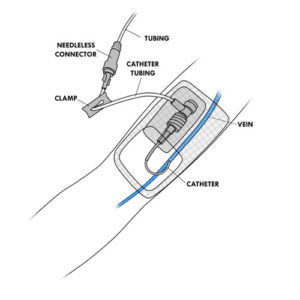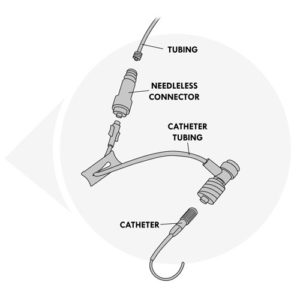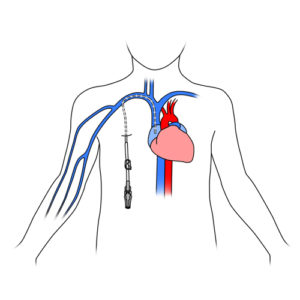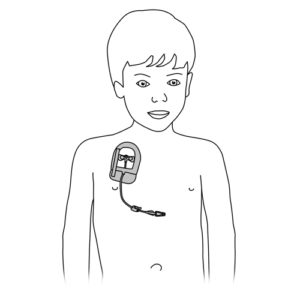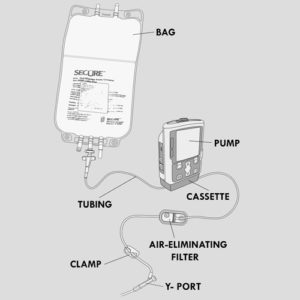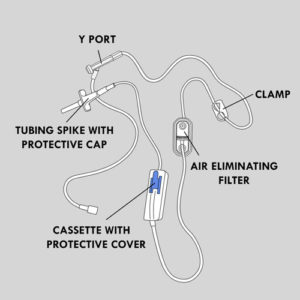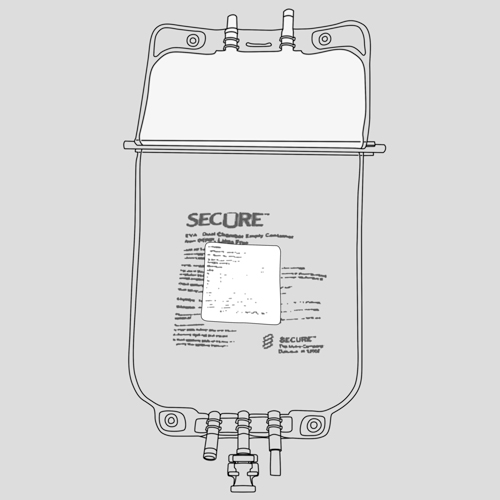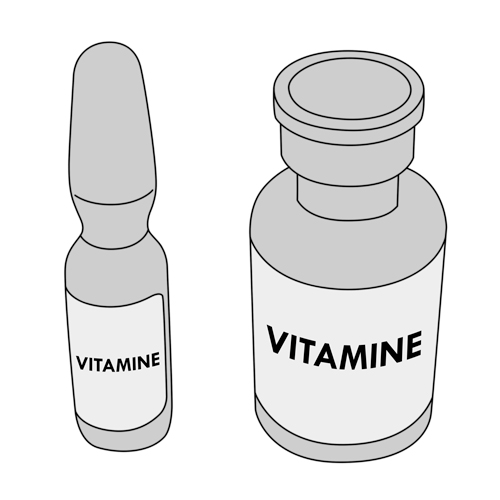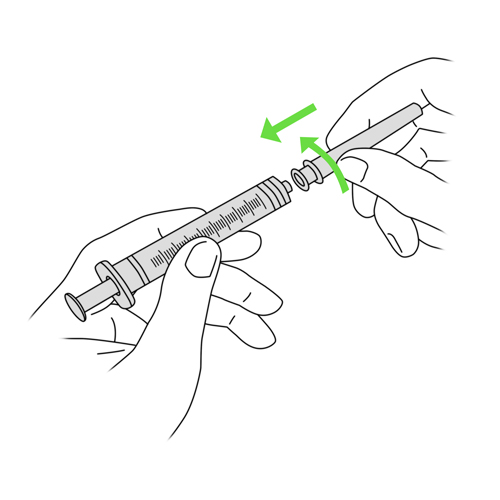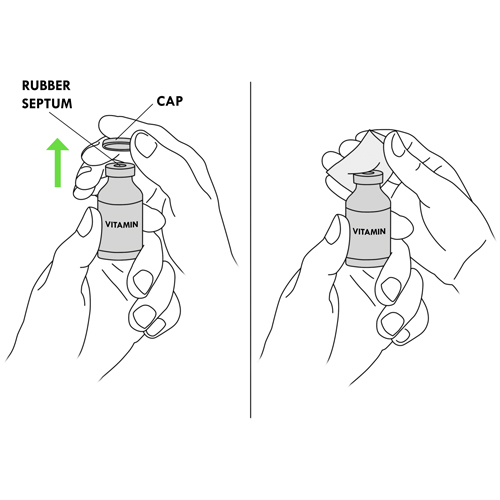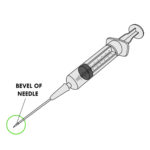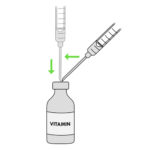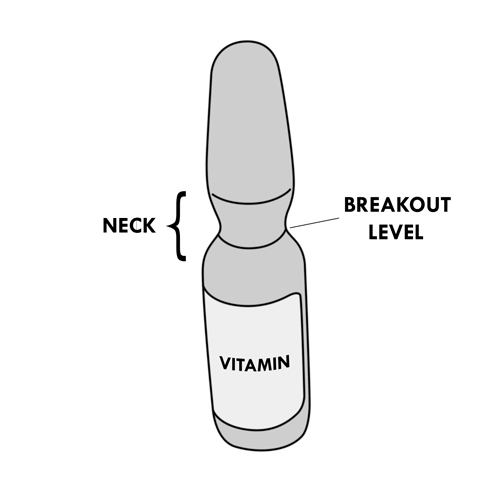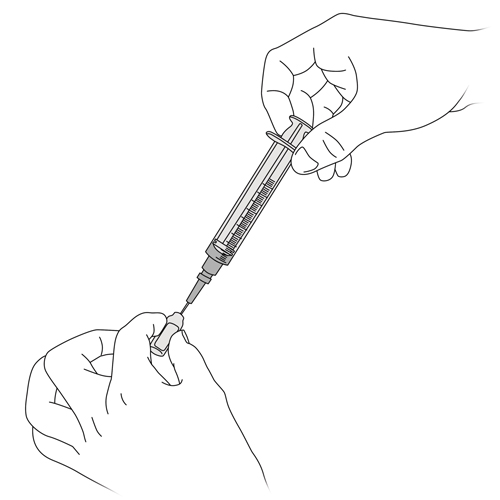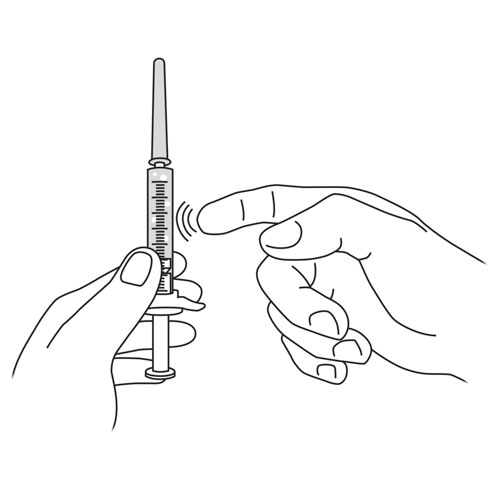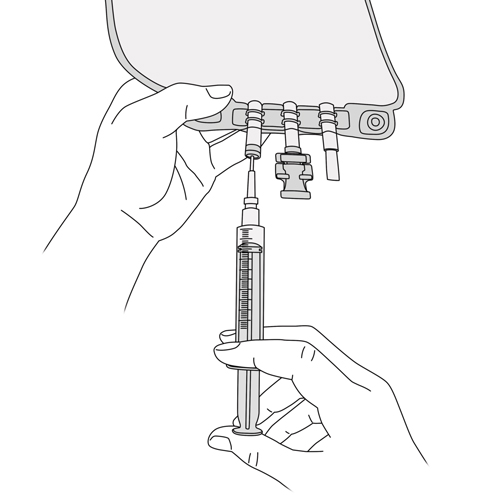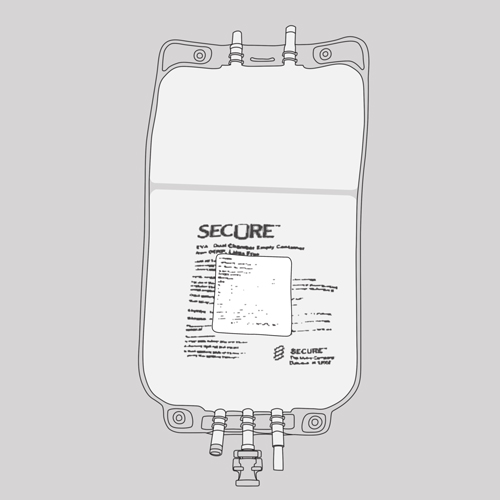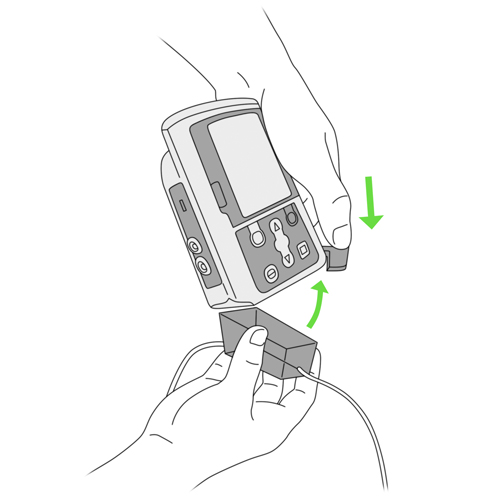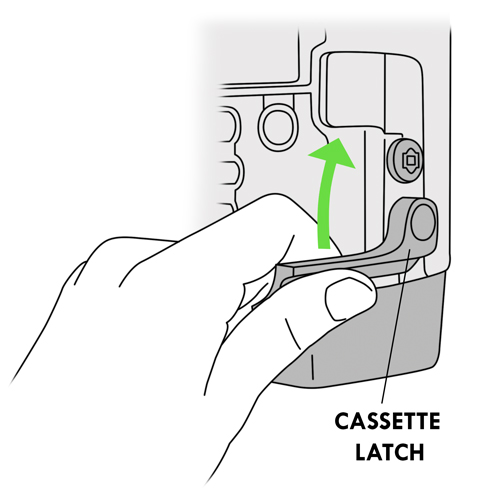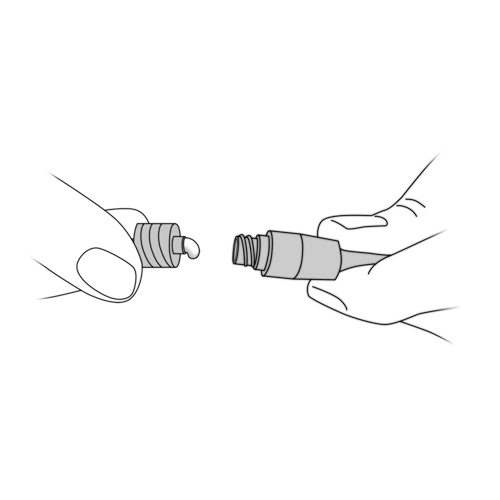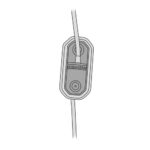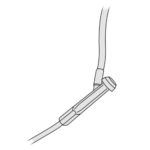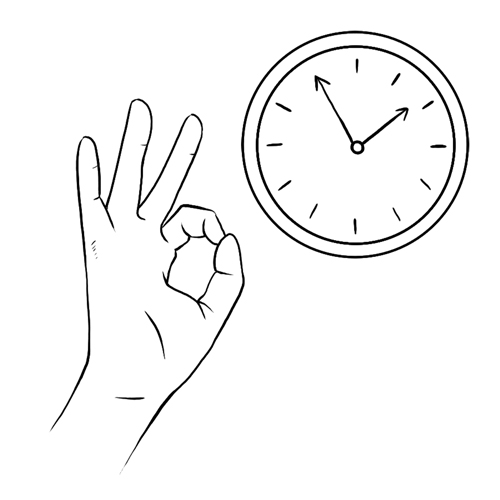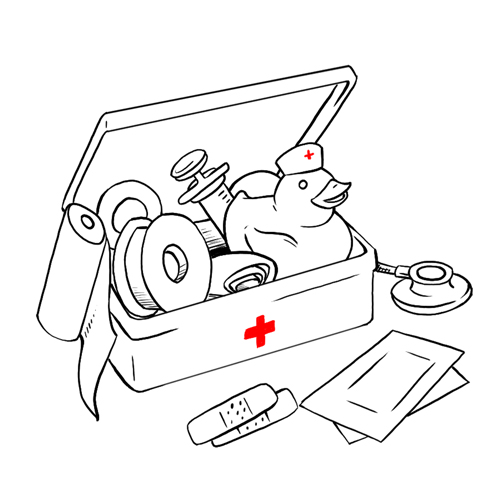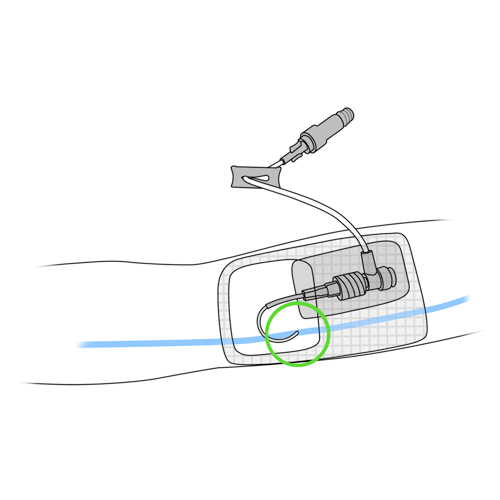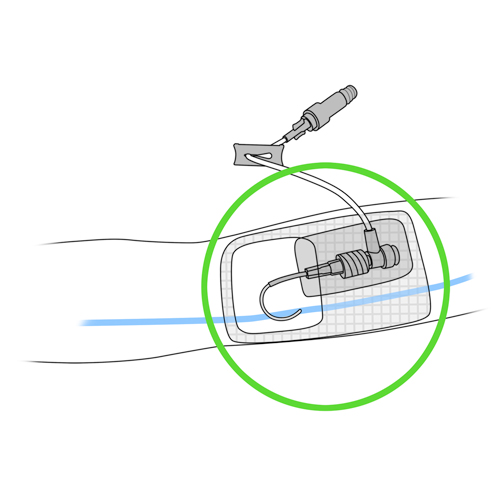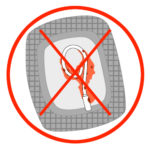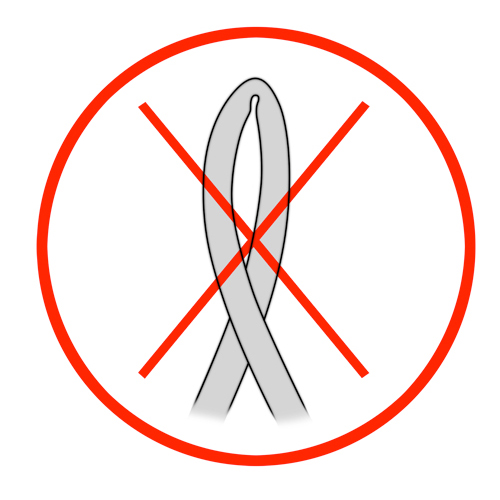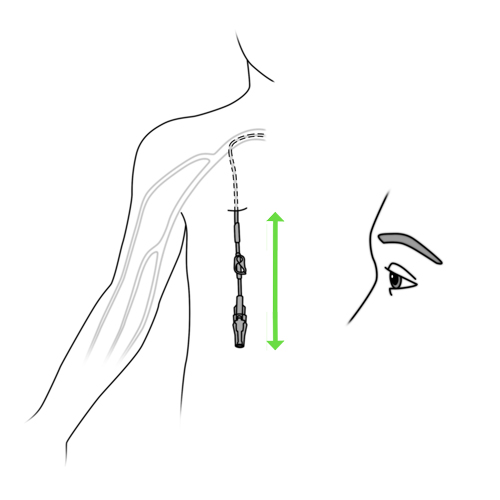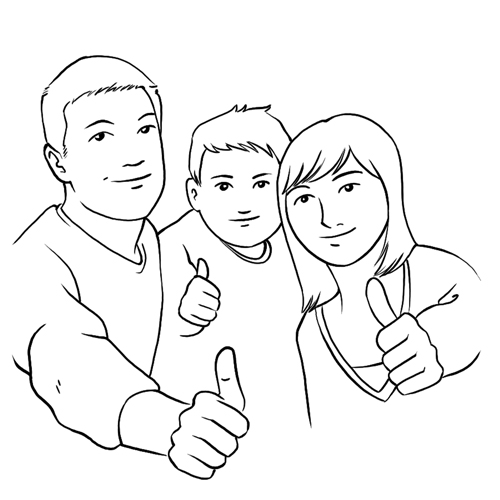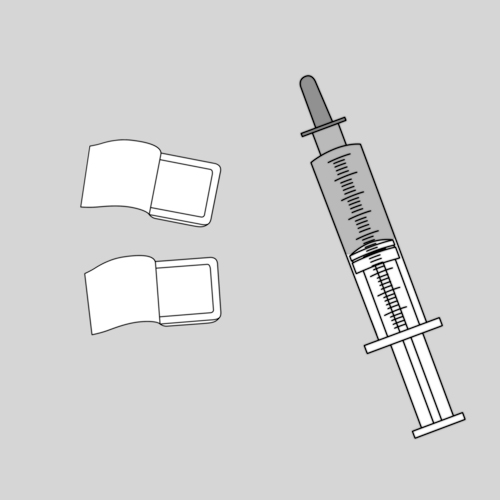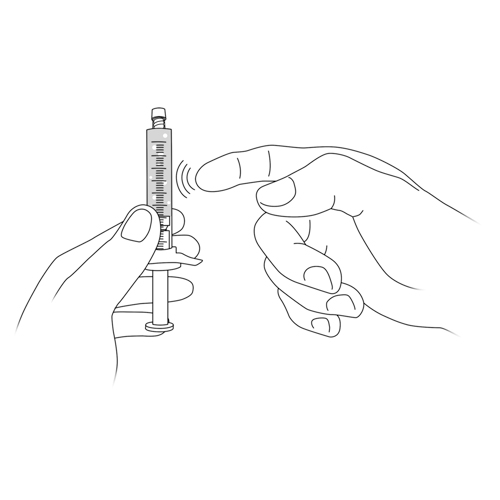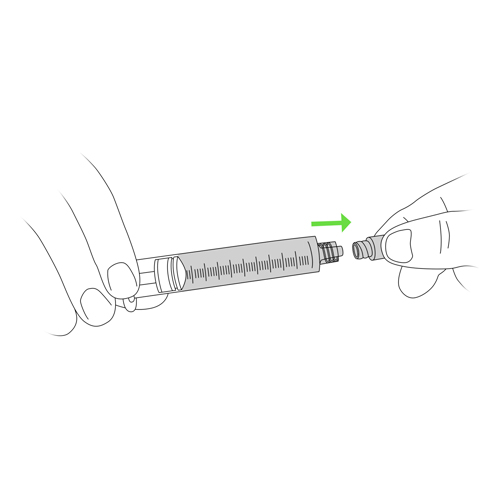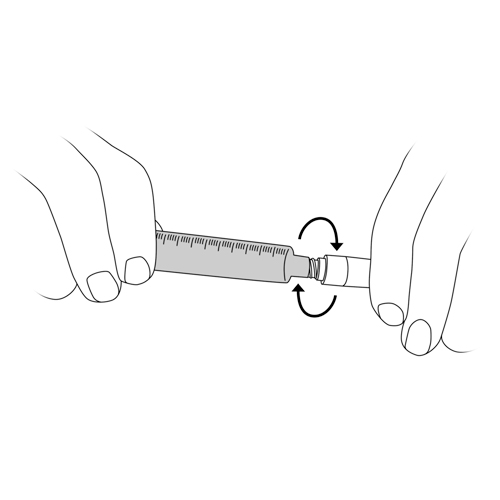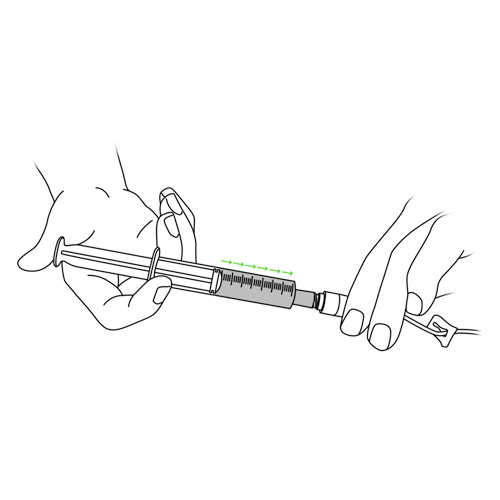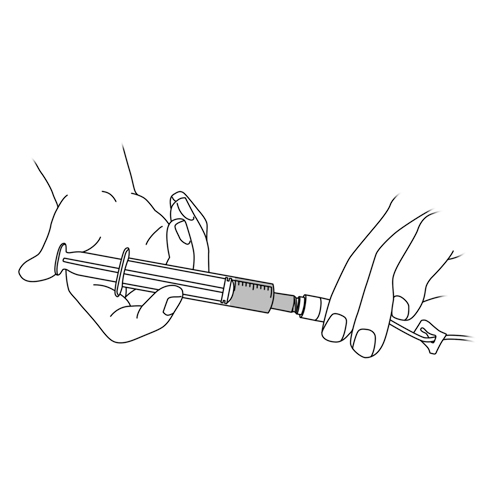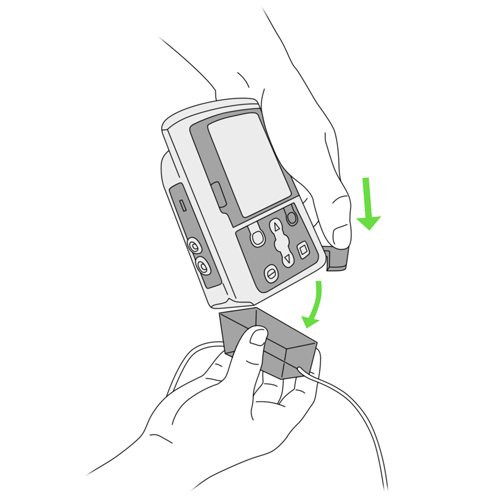WARNING: The information in this section is meant as a general guide to help parents and caregivers with common issues and is not intended to replace the care provided by your child’s healthcare team.
Discuss your child’s unique needs with the healthcare team, including WHO and WHEN to contact when problems arise.
Redness, heat, swelling or tenderness or pain at the catheter entry site
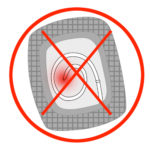
Possible cause(s)
- Infection or inflammation at the catheter entry site
- Phlebitis (irritated vein)
What to do?
- If the pump is running:
- press the “STOP / START” button on the pump in order to stop the infusion,
- close the clamp of the catheter tubing and the tubing of the pump.
- Contact your healthcare team quickly.
Extended redness or itching of the skin under dressing
Possible cause(s)
- Contact dermatitis (ie, irritation of the dressing on the skin)
- Allergy to the adhesive of the dressing
- Allergy to disinfectant solution
- Reaction of the skin to the disinfection technique
What to do?
- Contact your healthcare team who may suggest:
- a change in dressing materials,
- use of a topical corticosteroid,
- a change in disinfection technique.
Cord-like sensation of the vein where the catheter is inserted (may be hard, red or tender to touch)
Possible cause(s)
Phlebitis (irritated vein)
What to do?
- If the pump is running:
- press the “STOP/START” button on the pump in order to stop the infusion,
- close the clamp of the catheter tubing and of the tubing of the pump.
- Contact your healthcare team quickly.
One or more of these symptoms: burning or pain at the entrance site of the catheter, cold skin around the entrance site of the catheter, swelling of the arm (PICC line), swelling around the catheter site, leakage at catheter entry site, change in skin color (whiteness or redness) around the catheter entry site
Possible cause(s)
- Infiltration (the nutrition solution is leaking out of the vein and into the skin)
- Phlebitis of the vein (irritated vein)
What to do?
- If the pump is running:
- press the “STOP/START” button on the pump in order to stop the infusion,
- close the clamp of the catheter tubing and the tubing of the pump.
- Immediately contact your healthcare team.
- If your child’s arm with the catheter is swollen, lift it as much as possible.
For those with an implantable chamber catheter (eg, Port-a-Cath®): pain or swelling at the site of insertion of the reservoir during the administration of the solution or irrigation
Possible cause(s)
- Disconnection from the implantable chamber of the catheter
- Displacement of the catheter
- Displacement of the noncoring needle
What to do?
- If the pump is running:
- press the “STOP/START” button on the pump in order to stop the infusion,
- close the clamp of the catheter tubing and the tubing of the pump.
- If during irrigation:
- close the clamp of the catheter tubing,
- stop attempting to flush the line.
- Immediately contact your healthcare team.
Blood leaking at catheter insertion site
Possible cause(s)
- Breakage or disconnection of the catheter or tubing
- Recent catheter insertion
- Child’s underlying health condition
What to do?
- If there is continuous bleeding, put a compress over the dressing and apply firm pressure.
- If the pump is running:
- press the “STOP/START” button on the pump in order to stop the infusion,
- close the clamp of the catheter tubing and the tubing of the pump.
- Immediately contact your healthcare team.
Protective dressing is wet or damp due to leakage of blood, pus or other discharge
Possible cause(s)
- Breakage or disconnection of the catheter or tubing
- Blockage of the catheter
- Displacement of the catheter
- Displacement of the needle if the child has an implantable chamber device
- Infection
- Contact dermatitis
- Child’s underlying health condition
What to do?
- If the pump is running:
- press the “STOP/START” button on the pump in order to stop the infusion,
- close the clamp of the catheter tubing and the tubing of the pump.
- Immediately contact your healthcare team.
- If the dressing is falling off, put another dressing over it while waiting for the advice of your care team.
- If the dressing is partially detached, do not remove it as you might remove the catheter by mistake.
Dressing is falling off, loose, punctured or torn
Possible cause(s)
Various causes
What to do?
- If the dressing is falling off, tape the sides down.
- If it is punctured or torn, install another clear adhesive dressing over the old one.
- If the dressing is partially detached, do not remove it as you can remove the catheter by mistake.
- Immediately contact your healthcare team.
Presence of blood in catheter tubing
Possible cause(s)
Return of blood (reflux)
What to do?
- Irrigate the catheter with the saline solution. Refer to steps 5 and 8 to 12 of the “Catheter irrigation” care method.
- If this happens more than once or twice a week, contact your healthcare team.
More residual solution than usual in the bag at the end of administration
Possible cause(s)
Pump malfunction
What to do?
Contact your pharmacy or healthcare team quickly.
More air bubbles than usual or presence of particles in the bag, whether the additives have already been added or not
Possible cause(s)
- Contamination of the solution
- Problems in preparing the solution
- Heat-exposed bag
What to do?
- Do not administer the medication.
- Contact your pharmacy or healthcare team quickly.
Re-separation of the solution (before or during administration) after mixing the contents of the two chambers
Possible cause(s)
- Contamination of the solution
- Problems in preparing the solution
What to do?
- Do not administer the solution.
- If during the administration: press the “STOP/START” button on the pump and close the catheter tubing clamp and the pump tubing clamp.
- Contact your pharmacy or healthcare team quickly.
Ambulatory infusion pump alarms
Possible cause(s)
Various
What to do?
- Close the clamp of the catheter tubing and the tubing of the pump.
- Press the “SILENCE” button to stop the alarm tone.
- Look at the message on the screen.
- Follow the instructions accordingly.
- If a help screen is available for the alarm, follow the instructions provided.
- If necessary, consult the pump instructions that you have been given.
- If you still can not resolve the problem, contact your healthcare team.
Resistance or inability to irrigate (flush) the catheter
Possible cause(s)
- Blockage or displacement of the catheter
- Blockage of the tubing
- Clamps are closed
- Displacement of the needle in children with an implantable chamber device (PORT)
What to do?
- Do not push the plunger of the syringe with saline solution or locking solution forcefully.
- Make sure tubing clamps are fully open.
- Check that the tubing is not pinched or bent.
- Ask your child to:
- move the arm on the side of the catheter,
- turn on each side,
- cough,
- turn the head towards the opposite side of the catheter or to bear down (as if they were going to have a bowel movement).
- If your child has an implantable chamber catheter (eg, Port-a-Cath®): check if the needle has moved out of the correct position.
- If the problem persists:
- close the clamp of the catheter tubing,
- stop attempting to flush the line,
- contact your healthcare team immediately.
Inadvertent disconnection of connector without needle or pump tubing
Possible cause(s)
- Accident
- Mishandling
What to do?
- If the pump is running:
- press the “STOP/START” button on the pump in order to stop the infusion,
- close the clamp of the catheter tubing and the tubing of the pump.
- Immediately contact your healthcare team.
Broken (leaking) catheter or malfunctioning equipment
Possible cause(s)
- Mishandling
- Catheter or other defective equipment
- Blocked catheter
What to do?
- You may notice a flow of blood or fluid at the point where the catheter or other piece of equipment is broken.
- If the pump is running:
- press the “STOP/START” button on the pump in order to stop the infusion,
- close the clamp of the catheter tubing and the tubing of the pump.
- If you can see where the equipment is broken or where the leakage is coming from:
- close the clamp between the catheter and the point of leakage.
- if there is no clamp, use the hemostat clamp, as your healthcare team has taught you, or bend the catheter in half and keep it folded in place with tape.
- If you do not see where the leakage is coming from or where the equipment is broken: put a gauze compress on the dressing to absorb the leakage.
- Immediately contact your care team.
External displacement of the catheter (part of the catheter outside the vein shorter or longer than usual or catheter completely removed from the vein) with or without: pain in the ear, neck or shoulder on the side of the catheter, swelling in the neck, unusual sound heard by your child on the catheter side during flushing of the catheter or administration of the medication
Possible cause(s)
- Accidental displacement of the catheter
- Mishandling of the catheter
- Improperly adjusted dressing
- Child has moved excessively and displaced the catheter
What to do?
- Never push the catheter back into the vein.
- If the pump is running:
- press the “STOP/START” button on the pump in order to stop the infusion,
- close the clamp of the catheter tubing and the tubing of the pump.
- If the catheter has been completely pulled out, put a clear dressing over the previous entrance site.
- Immediately contact your healthcare team.
Unusual sound heard by your child on the catheter side during irrigation with or without: pain in the ear, throat pain
Possible cause(s)
Displacement of the internal (inside the body) portion of the catheter
What to do?
- Close the clamp of the catheter tubing.
- Stop attempting to flush the line.
- Immediately contact your healthcare team.
Particular odor or a strange taste reported by your child during catheter irrigation
Possible cause(s)
Contact between the saline solution and the plastic of the syringe may activate your child’s sense of taste and smell
What to do?
- This is commonly reported. There is no danger to your child’s health.
- If the taste is very intense, contact your healthcare team.
One or more of these symptoms: nausea, vomiting, headache, blurred vision, cold sweats, pallor, tiredness or irritability, seizures
Possible cause(s)
- Signs of hypoglycemia (low blood sugar)
- Rapid termination of solution administration
- Infection
What to do?
- Take your child’s blood glucose, if possible.
- Quickly give your child extra glucose (ask your child’s healthcare team for specific guidelines).
- Immediately contact your healthcare team.
Most hypoglycemia can be avoided by gradually decreasing the rate of the infusion in the last hour of delivery. Ask your child’s healthcare team for more specific instructions.
One or more of these symptoms: headache, nausea, increased thirst, weakness, agitation, irritability, increased urination
Possible cause(s)
- Signs of hyperglycaemia (high blood sugar)
- Infection
What to do?
- Take your child’s blood glucose, if possible.
- Immediately contact your healthcare team.
One or both of these symptoms: dry skin, dry mouth, significant thirst, weakness, dizziness, decreased urination
Possible cause(s)
Dehydration
What to do?
- Contact your healthcare team quickly.
- Give oral rehydration solutions to your child (eg, Pedialyte™, Gastrolyte™), if recommended by your healthcare team.
One or more of these symptoms: faster breathing, difficulty breathing, swelling especially in the legs/feet or around the eyes, decreased urination, unexpected rapid weight gain
Possible cause(s)
- Fluid overload in the body
- Lack of protein in the blood
- Infection
What to do?
- Immediately contact your healthcare team.
Fever with or without general malaise: ≥ 38⁰C rectal or ≥ 37.5⁰C buccal or ≥ 37.5⁰C armpit
Possible cause(s)
- Infection at the catheter entry site
- Blood infection
- Other infection
What to do?
- Note the other discomforts of your child (eg, pain, chills, difficulty breathing, blood in the stool, vomiting with blood, drowsiness, etc).
- Contact your healthcare team quickly.
One or more of these symptoms: swelling of the arm or side where the catheter is located, underarm pain in the arm where the catheter is located, swelling of the neck and face
Possible cause(s)
- Phlebitis of the vein (irritated vein)
- Blood clot in the vein with the catheter
What to do?
Immediately contact your healthcare team.
For specific advice on your child or any other questions, do not hesitate to contact your child’s healthcare team.
